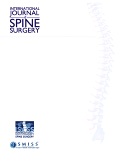
Allogeneic Disc Cells Improve Pain, Function, and Disc Volume in Lumbar Degeneration

Allogeneic Disc Cells Improve Pain, Function, and Disc Volume in Lumbar Degeneration
Allogeneic Disc Progenitor Cells Safely Increase Disc Volume and Improve Pain, Disability, and Quality of Life in Patients With Lumbar Disc Degeneration-Results of an FDA-Approved Biologic Therapy Randomized Clinical Trial.
Int J Spine Surg . 2024 Jul 4;18(3):237-248.Did you know you're eligible to earn 0.5 CME credits for reading this report? Click Here
Synopsis
Sixty patients with symptomatic single-level lumbar disc degeneration were randomized to receive high-dose disc progenitor cells (n=20), low-dose cells (n=20), vehicle (n=10), or placebo (n=10). The primary outcome of interest was a ≥30% improvement in visual analog scale (VAS) pain score at 52 weeks. Secondary outcomes included changes in Oswestry Disability Index (ODI), EQ-5D quality of life sco...
To view the full content, login to your account,
or start your 30-day FREE Trial today.
FREE TRIAL
LOGIN
Forgot Password?
Explore some of our unlocked ACE Reports below!

Learn about our AI Driven
High Impact Search Feature
Our AI driven High Impact metric calculates the impact an article will have by considering both the publishing journal and the content of the article itself. Built using the latest advances in natural language processing, OE High Impact predicts an article’s future number of citations better than impact factor alone.
Continue



 LOGIN
LOGIN

Join the Conversation
Please Login or Join to leave comments.